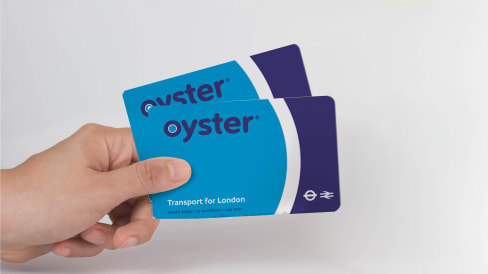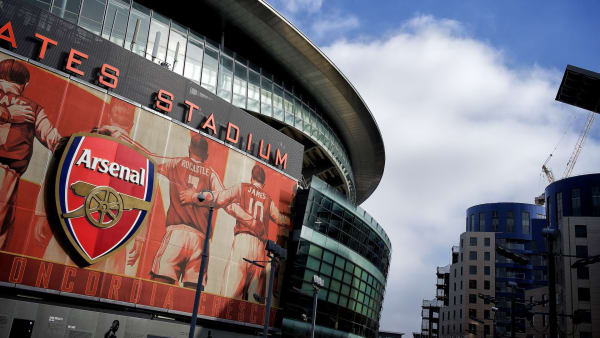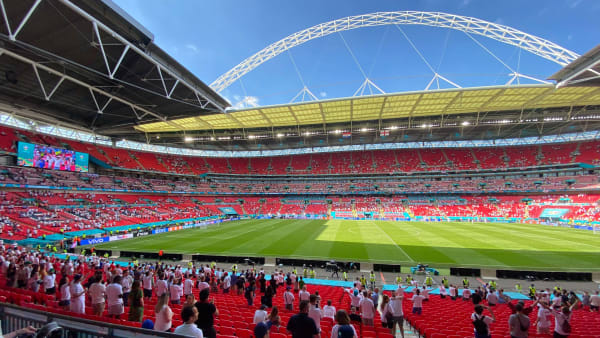Oyster card & contactless payment method
Oyster cards and contactless payment methods are the most common ways to pay for public transport journeys in London
Oyster card & contactless payment method
Oyster cards and contactless payment methods are the most common ways to pay for public transport journeys in London
An Oyster card is a smart transport card onto which you can load credit (to pay for journeys as you go) or transport passes. The pay-as-you-go option allows you to travel on London buses and trams, the Tube, the DLR, the London Overground, the IFS Cloud Cable Car, and the Thames Clippers River Bus services. As for travel passes, you can load the Oyster card with Travelcards or Bus & Tram Passes.

If you want to know more about Travelcard passes, their prices, and their benefits, you will find everything you need in our dedicated article.
A contactless payment method is simply a bank card (debit or credit) or mobile device that supports contactless payment. You can use American Express, MasterCard, Maestro, Visa, V PAY, Apple Pay, Barclaycard Contactless Mobile, bPay, Fitbit Pay, Garmin Pay, Google Pay, and Samsung Pay. You can use any of these contactless payment methods to pay as you go for your journeys on London public transport (buses, trams, Tube, DLR, London Overground, IFS Cloud Cable Car, and Thames Clippers River Bus services).
In terms of pay-as-you-go pricing, Oyster cards and contactless payment methods share the same system. The main differences have to do with the maximum price caps and activation fees. In the following sections of this article, you’ll find all the information you need on how to use either option, the differences, advantages and disadvantages of each, the zone system and pricing, as well as useful apps.
How to use an Oyster card or contactless payment method
Using an Oyster card or contactless payment method on public transport in London is very easy. If you are using a contactless method, all you have to do it is have it at hand when approaching the gates at an Underground station or when getting on the bus. If you’re using an Oyster, make sure the card has enough credit or is otherwise loaded with a transport pass.
All you have to do is tap your card or device at the start of your journey and tap it again when exiting your arrival station. Tapping upon exit is not necessary on bus or tram journeys. At Underground stations, the entrance gates have yellow card readers, while the readers on buses are usually by the driver’s cabin.
Remember to use the same device or card when touching in and out, otherwise, you will be charged the maximum fare on both devices. Keep in mind that you have to have one card or device per person. You cannot share the same Oyster or contactless payment method if you are travelling together.
If you need to reload your Oyster with credit, you can do so at any Underground station (they have automatic ticket machines), at Visitor Centres , at some DLR stations, at Oyster Ticket Stops in London newsagents, or through the TfL Oyster app.
If you are using contactless payment methods, your journey fare will accumulate and you will be charged once at the end of the day. Remember that if your bank card was issued outside of the UK, you might be charged currency conversion rates by your bank.
Prices and fares are calculated on the basis of the zone system.
Zone system in London
For the purpose of public transport pricing, London is divided into 9 concentric zones. The first important thing to know is that zones 1 and 2 are the most central ones and they correspond to the inner city, where the majority of the attractions and monuments can be found. These are the areas where you will likely spend the majority of your time as a tourist. Here are some important sites you can find outside zone 1 and 2.
- Heathrow Airport - Zone 6
- Gatwick Airport - Zone 6
- Wembley Stadium - Zone 4
- Wimbledon (All England Lawn Tennis and Croquet Club) - Zone 3
- Hampton Court - Zone 6
Another important thing to note about these zones is that while the London Rails and Underground system (which includes the Tube, the DLR, and Overground) respond to this zone system in terms of pricing, London buses do not. This means that even though London buses operate throughout the 9 zones, bus journeys always cost the same, no matter how many zones you travel through.
How much is an Oyster card?
Seeing as the Oyster is a physical card, it must be first of all purchased at a selling point. You can get one in all Tube and London Overground stations, at an Oyster Ticket Stop at a London newsagent, at Visitor Centres , and in some DLR stations.
The cost of the physical Oyster card is £7.00. This is a non-refundable price that does not contribute to the credit on your card. As for the cost of each journey when using an Oyster card, you can check the following section regarding the pay-as-you-go fares.
Keep in mind that there is also a second type of Oyster card that you can buy, called a Visitor Oyster card, which costs £5.00 (non-refundable fee). The Visitor Oyster card cannot be bought in London. You have to buy a Visitor Oyster in advance online and have it delivered to you before you go to London.
However, while the regular Oyster card can be loaded with a Travelcard or be used to pay as you go, the Visitor Oyster card can only be loaded with credit to pay for your journeys as you go. For this reason, as well as having to order the card in advance, we recommend you get a regular Oyster card rather than a Visitor Oyster.
Pay-as-you-go fares
Pay-as-you-go journey fares are the same for Oyster cards and contactless payment methods. For the entire Underground network (Tube, DLR, Overground), the prices are calculated on the basis of peak/off-peak hour usage and zone coverage. This means that all journeys within the same zone cost the same. The price goes up the more zones you travel through during your journey.
Peak hours are Monday to Friday between 6:30 am and 9:30 am, and between 4:00 pm and 7:00 pm. Off-peak hours are all other times. Additionally, if you travel from a station outside Zone 1 to a station within Zone 1, between 4:00 pm and 7:00 pm (even Monday to Friday), that is also considered off-peak.
The pay-as-you-go fares you’ll pay most often with an Oyster card or contactless payment method are £2.80 and £3.40 (when you’re travelling in zone 1 or between zone 1 and 2 at peak hours) or £2.70 and £2.80 (when you’re travelling in those zones at off-peak hours).
If a station is between two zones (like Turnham Green or the Greenwich stations), you can choose to make it count for whichever zone is more convenient for you.
This system does not apply to bus journeys, which always cost £1.75, no matter how many zones you cross or what time you get on or off the bus. You can see a summary of all single journey costs in the following table.
| Transport |
|---|
| Hours |
| Zone 1 |
| Zone 2 |
| Zone 1-2 |
| Zone 1-3 |
| Zone 1-4 |
| Zone 1-5 |
| Zone 1-6 |
| Zone 1-7 |
| Zone 1-8 |
| Zone 1-9 |
| Zone 2-6 |
| Transport | Bus | London Underground network | London Underground network |
|---|---|---|---|
| Hours | All hours | Peak hours | Off-peak |
| Zone 1 | £1.75 | £2.80 | £2.70 |
| Zone 2 | £1.75 | £1.90 | £1.80 |
| Zone 1-2 | £1.75 | £3.40 | £2.80 |
| Zone 1-3 | £1.75 | £3.70 | £3.00 |
| Zone 1-4 | £1.75 | £4.40 | £3.20 |
| Zone 1-5 | £1.75 | £5.10 | £3.50 |
| Zone 1-6 | £1.75 | £5.60 | £3.60 |
| Zone 1-7 | £1.75 | £6.00 | £4.40 |
| Zone 1-8 | £1.75 | £7.40 | £4.40 |
| Zone 1-9 | £1.75 | £7.50 | £4.50 |
| Zone 2-6 | £1.75 | £3.30 | £1.90 |
*Children under 11 can use buses, the Tube, DLR, Overground and any Transport for London (TfL) train for free.
The only difference between using an Oyster card and a contactless payment method to pay for your journeys as you go is the maximum price cap.
Remember that if you have an Oyster card, aside from paying for your journeys as you go, you can also load daily or weekly Travelcards on it. To learn more about the Travelcard, read our dedicated article.
Price caps
Both Oyster cards and contactless payment methods have a price cap when it comes to pay-as-you-go options. This means that no matter how much you travel during a set time, you will never be charged over the set price cap.
While the Oyster card and contactless payment methods both have a daily cap, only the latter has a weekly cap. The weekly cap applies strictly from Monday to Sunday, and not over the course of 7 random consecutive days (like Wednesday-Tuesday, for example).
For the purposes of ticket validity and cap calculation, each day is considered to start at 4:30 am and end at 4:29 am the following day. This means that a weekly cap applies to the period from Monday morning at 4:30 am to the following Monday at 4:29 am (the night going from Sunday to Monday).
As a tourist, you are likely to only travel in zones 1-2, so your Oyster daily cap will be £8.10. If you are using a contactless payment method you will also have a weekly cap of £40.70. For bus-exclusive travel, the daily cap is always £5.25. You can see all daily and weekly caps summarised in the following table.
| Zone |
|---|
| Zone 1-2 |
| Zone 1-3 |
| Zone 1-4 |
| Zone 1-5 |
| Zone 1-6 |
| Zone 1-7 |
| Zone 1-8 |
| Zone 1-9 |
| Zone | Bus only cap (1-day) | Daily cap(Oyster & contactless) | Weekly cap(only contactless) |
|---|---|---|---|
| Zone 1-2 | £5.25 | £8.10 | £40.70 |
| Zone 1-3 | £5.25 | £9.60 | £47.90 |
| Zone 1-4 | £5.25 | £11.70 | £58.50 |
| Zone 1-5 | £5.25 | £13.90 | £69.60 |
| Zone 1-6 | £5.25 | £14.90 | £74.40 |
| Zone 1-7 | £5.25 | £15.30 | £76.50 |
| Zone 1-8 | £5.25 | £18.10 | £90.30 |
| Zone 1-9 | £5.25 | £20.00 | £100.20 |
Is it cheaper to use an Oyster card or a contactless payment method?
As far as pay-as-you-go journey fares for adults go, having an Oyster card or using a contactless payment method is the same. The cost of each journey and the daily price caps are the same.
As you will have noticed, contactless payment methods have a weekly cap (applied strictly Monday to Sunday), while Oyster cards don’t when using them for pay-as-you-go travel. However, what you can do is load the Oyster card with a weekly Travelcard, which costs the same as the maximum weekly price cap on contactless.
The additional benefit of the Oyster card here is that the weekly Travelcard does not apply strictly from Monday through Sunday, but rather to a natural week (Wednesday through the following Tuesday, for example). If you want to learn more about the Travelcard, all the information you need is in our dedicated article.
However, there are a few things to consider about both options. First of all is the Oyster card activation cost (£7.00), which is non-refundable. On the other is the currency exchange fee that you might be charged when using contactless if your bank account is from outside the UK.
In conclusion, these are our recommendations for the cheapest travel rates on London transport.
- If you are in London only for a few days and you are sure that your bank won’t charge you extravagant conversion fees, use a contactless payment method.
- If you are in London for a week (Monday through Sunday) and you are sure that your bank won’t charge you extravagant conversion fees, use a contactless payment method.
- If you are in London for a week (not Monday through Sunday), get an Oyster card and load it with a Travelcard.
- If you are in London for less than a week and think that your bank may charge you a lot in conversion fees, get an Oyster card and load it once with enough money for your entire stay (pay-as-you-go journeys).
Oyster card app
The TfL Oyster and contactless app is a free app that helps you manage your London transport cards.
With it, you can top up your pay-as-you-go credit on your Oyster card, check your journey history, as well as load Travelcards or Bus & Tram passes on your Oyster card.














